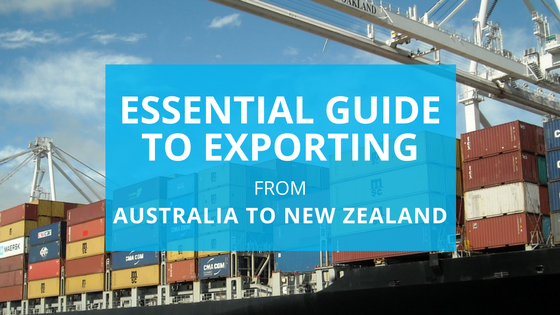Essential Guide Before You Export to New Zealand
Exporting goods to New Zealand is a great option if you are looking to expand your reach as a business. This guide will help small businesses learn key information and explore the best ways on exporting to New Zealand from Australia.
Getting your goods in front of more people is a fantastic way to expand your market. Especially for Australian businesses exporting to countries like New Zealand.
According to the Department of Foreign Affairs and Trade, New Zealand is the 7th largest market for Australian exports. Major exports include computer & telecommunication parts, medical instruments and passenger vehicles.
Before we talk about exporting to New Zealand, you should read our guide to exporting from Australia — It will help you understand how to get your business ready for exporting, provides key resources to help you, and covers taxes, tariffs, and financial assistance. These subjects will not be covered in this guide, so be sure you’ve got an understanding before reading on.
There’s also lots of fantastic advice for exporting to New Zealand here.

In this guide we’ll cover:
- Finding the right products to export to New Zealand.
- Understanding the types of products you can (and can’t) export.
- The best ways to export products to New Zealand.
- Costs to export containers from Australia to New Zealand.
- Understanding licenses for exporting to New Zealand.
- Export and import duty, tariffs, and taxes.
- Getting paid in foreign currency.
Finding the right products to export to New Zealand
The best thing that could happen when exporting to New Zealand is making a profit from selling your products. However, it can be difficult if you are trying to penetrate a market that has a constant supply or worse, no demand for the product you wish to export. Make sure you research the market before jumping in on exporting.
- Avoid food and perishables — Food and produce are very expensive to export, since you need specialized shipping. Additionally, food exports are subject to strict criteria, so you’re best off avoiding them altogether.
- Do your market research — The Warehouse and Trade Me, both online marketplaces, have a huge presence in New Zealand — You can certainly sell through these marketplaces, and they’re a good place to start when it comes to market research. Additionally, look into specialised market reports on what sells in New Zealand.
- Aim at luxury products — Ideally, you’ll want to provide “luxury” items that aren’t produced domestically in New Zealand. These can be lifestyle goods and aspirational products, often with a strong aesthetic. Think clothes, furniture, cars, electronics, accessories, and designer items.
- Understand your margins and pricing — Exporting can eat into your margins — Make sure you’ve got a rock-solid understanding of all your costs and the price you want to sell at, and account for exchange rates to make sure you can still turn a profit.

Understanding the types of products you can and can’t export to New Zealand
Australia export restrictions
The Australian authorities prevent or restrict goods like some chemicals, biological materials, pharmaceuticals, animal and plant species, weapons, and more from export. You can find a complete list here. You should also learn what Australian Customs needs from you if you want to export.
New Zealand import restrictions
Controlled imports include agricultural items and food, chemical weapons, chewing tobacco, certain animals and endangered species, explosives, and more. For the full list, refer here.
The best ways to export products to New Zealand
International shipping and exporting to New Zealand for the first time can be complicating. It could be worth hiring someone who has experience in that area to help you.
Generally, this is the process involved:
- You manufacture or purchase the items domestically, in Australia OR you manufacture them elsewhere and arrange for shipping from there to New Zealand.
- You understand the various regulations, tariffs, and licenses you need to export.
- You arrange for international shipping from the point of origin to New Zealand— For larger items and big quantities, you will typically use container cargo, for smaller quantities, you might use an international shipper like FedEx.
- On arrival of your goods in New Zealand you pay the necessary duty, tariffs, and any other fees.
- You arrange for your goods to be held on your behalf in New Zealand.
- You market your goods for sale in New Zealand, often through a retail store, third-party marketplace, ecommerce website, or some other outlet.
- You sell your goods and arrange for them to be sent to your customers.
- You get paid and transfer your money back to Australia.
- You pay any necessary local taxes in New Zealand and Australia.

Typical container costs — Shipping from Australia to New Zealand
International shipping might not be as expensive as you think. According to the Sea Freight Calculator, the cost of renting a full container to ship goods from Australia to New Zealand is approximately:
20 ft container — $1,000 USD
40 ft container — $1,300 USD
And according to Australia Trade, renting part of a container will cost you between $150 and $250 AUD per cubic meter or 1,000 kilos, whichever is greater.
Remember that these are only shipping costs — The cost of actually having your goods freighted from one port to another. They don’t include costs involved in getting your goods to a warehouse, insurance, duties, and other fees. Make sure you understand your total logistics costs so you can factor them into your pricing.
We’d advise you to compare a number of quotes from shipping companies and suppliers based on the type and quantity of goods you want to export.
Understanding licenses for exporting to New Zealand
You are not required to obtain import licenses when importing most goods into New Zealand.
However, you are required to get specific certificates and permits when importing endangered plant and animal species and products as well as animal remedies and pesticides.
Note that the rules and regulations around importing and exporting to and from New Zealand do change from time to time. Make sure you check with official sources to ensure you’ve always got the latest information.
Export and import tariffs, duties, and taxes for New Zealand
New Zealand tariffs are not applied to Australian products which contain at least 50% Australian contents. You typically won’t have to pay goods and services tax to Australian authorities for exporting from the country, although you may need to pay some processing fees.
Make sure you do your research, understand what you’re getting into, and plan carefully. Then you’ll be ready to launch and sell your products.
What about receiving money in foreign currency?
Until recently, Australian businesses had 3 options to receive money from overseas customers:
- Get paid into a local Australian based, Australian dollar account.
- Open a Foreign Currency Account, usually with a bank
- Use a payment gateway like PayPal, Braintree or Stripe
Unfortunately, these options are usually filled with fees, balance requirements or massive exchange rate mark-ups.
Wise
In October 2017, Wise (formerly TransferWise) released its multi-currency account in Australia. It allows you to receive, hold and transfer 27 different currencies.
A unique feature that is particularly useful for businesses, is the ability to have local bank account details in USD, EUR, GBP, NZD, CAD or AUD. This makes receiving money from overseas customers really easy.
Learn more about the Wise Account
WorldFirst
There is a lot to like about the services that WorldFirst offer. WorldFirst could be especially a good option for businesses who currently use their regular bank for international payments. If your business needs to make regular or large payments, you might find that using a service like WorldFirst could help save a lot of money.
- Their website is easy to use. You should find that that set up and registration process is quite simple. This means you can be up and running, ready to make transfers in no time!
- They have competitive rates, and a lot of the time these will be better than what you'd find at your bank.
- For businesses, they have very competitive terms and offer specific support for online sellers.
- WorldFirst doesn't charge any fees. This makes calculating the cost of your transfer easier, as you only need to worry about the rate they are offering.
- They offer a number of products, including forward contracts if you're not constrained by time.
For the full review of WorldFirst, click here.